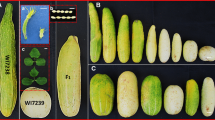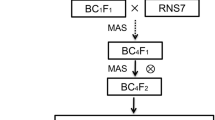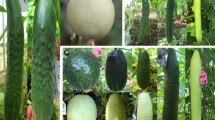Abstract
Key message
Through a novel phenotyping method, four QTLs were consistently associated with increased parthenocarpic fruit set in North American processing cucumber that accounted for over 75 % of observed phenotypic variation.
Abstract
Parthenocarpy is a desirable trait with potential for increasing yield and quality in processing cucumber production. Although many successful parthenocarpic fresh market cucumber varieties have been developed, the genetic and molecular mechanisms behind parthenocarpic expression in cucumber remain largely unknown. Since parthenocarpy is an important yield component, it is difficult to separate the true parthenocarpic character from other yield related traits. In the present study, we developed a novel phenotypic approach for parthenocarpic fruit set focusing on early fruit development. Two hundred and five F3 families derived from a cross between the highly parthenocarpic line 2A and low parthenocarpic line Gy8 were phenotypically evaluated in three greenhouse experiments. Seven QTLs associated with parthenocarpic fruit set were detected. Among them, one each on chromosomes 5 and 7 (parth5.1 and parth7.1) and two on chromosome 6 (parth6.1 and parth6.2) were consistently identified in all experiments, but their relative contribution to the total phenotypic variation was dependent on plant growth stages. While each of the four QTLs had almost equal contribution to the expression of the trait at commercial harvest stage, parth7.1 played an important role in early parthenocarpic fruit set. The results suggested that parthenocarpic fruit set can be accurately evaluated with as few as 20 nodes of growth. The QTLs identified in this study for parthenocarpic fruit set are a valuable resource for cucumber breeders interested in developing parthenocarpic cultivars and to researchers interested in the genetic and molecular mechanisms of parthenocarpic fruit set.




Similar content being viewed by others
References
Aalbersberg W, van Wijchen G (1987) Parthenocarpic gherkins: newcomer is a distinct improvement. Groenten En Fruit 42:66–67
Beraldi D, Picarella ME, Soressi GP, Mazzucato A (2004) Fine mapping of the parthenocarpic fruit (pat) mutation in tomato. Theor Appl Genet 108:209–216
Beyer EM Jr, Quebedeaux B (1974) Parthenocarpy in cucumber: mechanism of action of auxin transport inhibitors. J Amer Soc Hort Sci 99:385–390
Bo K, Ma Z, Chen J, Weng Y (2014) Molecular mapping reveals structural rearrangements and quantitative trait loci underlying traits with local adaptation in semi-wild Xishuangbanna cucumber (Cucumis sativus L. var. Xishuangbannanesis Qi et Yuan). Theor Appl Genet 128:25–39
Broman KW, Wu H, Sen S, Churchill GA (2003) R/qtl: QTL mapping in experimental crosses. Bioinformatics 19:889–890
Cantliffe DJ, Phatak SC (1975) Use of ethephon and chlorflurenol in once-over pickling cucumber production system. J Amer Soc Hort Sci 100:264–267
Carmi N, Salts Y, Dedicova B, Shabtai S, Barg R (2003) Induction of parthenocarpy in tomato via specific expression of the rolb gene in the ovary. Planta 217:726–735
Cavagnaro PF, Senalik DA, Yang LM, Simon PW, Harkins TT, Kodira CD, Huang SW, Weng Y (2010) Genome-wide characterization of simple sequence repeats in cucumber (Cucumis sativus L.). BMC Genom 11:569
Choudhury B, Phatak SC (1959) Sex expression and fruit development in cucumber (Cucumis sativus L.) as affected by gibberellin. Indian J Hort 16:233–235
Costantini E, Landi L, Silvestroni O, Pandolfini T, Spena A, Mezzetti B (2007) Auxin synthesis-encoding transgene enhances grape fecundity. Plant Physiol 143:1689–1694
de Menezes CB, Maluf WR, de Azevedo SM, Faria MV, Nascimento IR, Nogueira DW, Gomes LAA, Bearzoti E (2005) Inheritance of parthenocarpy in summer squash (Cucurbita pepo L.). Genet Mol Res 4:39–46
de Ponti OMB (1976) Breeding parthenocarpic pickling cucumbers (Cucumis sativus L): necessity, genetic possibilities, environmental influences and selection criteria. Euphytica 25:29–40
de Ponti OMB, Garretsen F (1976) Inheritance of parthenocarpy in pickling cucumbers (Cucumis sativus L.) and linkage with other characters. Euphytica 25:633–642
de Stigter HCM (1969) Growth relations between individual fruits, and between fruits and roots in cucumber. J Exp Bot 27:87–97
Denna DW (1973) Effect of genetic parthenocarpy and gynoecious habit on fruit production and growth of cucumber, Cucumis sativus L. J Amer Soc Hort Sci 98:602–604
Donzella G, Spena A, Rotino GL (2000) Transgenic parthenocarpic eggplants: superior germplasm for increased winter production. Mol Breeding 6:79–86
Elassar G, Rudich J, Palevitch D, Kedar N (1974) Induction of parthenocarpic fruit development in cucumber by growth regulators. HortSci 9:238–239
El-Shawaf IIS, Baker LR (1981) Inheritance of parthenocarpic yield in gynoecious pickling cucumber for once-over mechanical harvest by diallel analysis of six gynoecious lines. J Amer Soc Hort Sci 106:365–370
Fazio G, Staub JE, Stevens MR (2003) Genetic mapping and QTL analysis of horticultural traits in cucumber (Cucumis sativus L.) using recombinant inbred lines. Theor Appl Genet 107:864–874
Federer WT, Crossa J (2012) I.4 Screening experimental designs for quantitative trait loci, association mapping, genotype-by environment interaction, and other investigations. Front Physiol 3:156
Federer WT, Raghavarao D (1975) On augmented designs. Biometrics 31:29–35
Ficcadenti N, Sestili S, Pandolfini T, Cirillo C, Rotino GL, Spena A (1999) Genetic engineering of parthenocarpic fruit development in tomato. Mol Breeding 5:463–470
Fos M, Nuez F, Garcia-Martinez JL (2000) The gene pat-2, which induces natural parthenocarpy, alters the gibberellin content in unpollinated tomato ovaries. Plant Physiol 122:471–479
Fos M, Proano K, Alabadi D, Nuez F, Carbonell J, Garcia-Martinez JL (2003) Polyamine metabolism is altered in unpollinated parthenocarpic pat-2 tomato ovaries. Plant Physiol 131:359366
Fu FQ, Mao WH, Zhou YH, Asami T, Yu JQ (2008) A role of brassinosteroids in early fruit development in cucumber. J Exp Bot 59:2299–2308
Gillaspy G, Ben-David H, Gruissem W (1993) Fruits: a developmental perspective. Plant Cell 5:1439–1451
Gorguet B, van Heusden A, Lindhout P (2005) Parthenocarpic fruit development in tomato. Plant Biol 7:131–139
Gorguet B, Eggink PM, Ocana J, Tiwari A, Schipper D, Finkers R, Visser RGF, van Heusden AW (2008) Mapping and characterization of novel parthenocarpy QTLs in tomato. Theor Appl Genet 116:755–767
Gruber J, Bangerth F (1990) Diffusible IAA and dominance phenomena in fruits of apple and tomato. Physiol Plant 79:354–358
Gusmini G, Wehner TC (2008) Fifty-five years of yield improvement for cucumber, melon, and watermelon in the United States. HortTechnol 18:9–12
Kikuchi K, Honda I, Matsuo S, Fukuda M, Saito T (2008) Stability of fruit set of newly selected parthenocarpic eggplant lines. Sci Hort 115:111–116
Kim IS, Okubo H, Fujieda K (1992a) Endogenous levels of IAA in relation to parthenocarpy in cucumber (Cucumis sativus L.). Sci Hort 52:1–8
Kim IS, Okubo H, Fujieda (1992b) Genetic and hormonal control of parthenocarpy in cucumber (Cucumis sativus L.). J Fat Agr Kyushu Univ 36:173–181
Lee TD, Bazzaz FA (1982a) Regulation of fruit and seed production in an annual legume, Cassia fasciculata. Ecology 63:1363–1373
Lee TD, Bazzaz FA (1982b) Regulation of fruit maturation pattern in an annual legume, Cassia fasciculata. Ecology 63:1374–1388
Li YH, Yang LM, Pathak M, Li DW, He XM, Weng Y (2011) Fine genetic mapping of cp, a recessive gene for compact (dwarf) plant architecture in cucumber, Cucumis sativus L. Theor Appl Genet 123:973–983
Lloyd DG (1980) Sexual strategies in plants. I. An hypothesis on serial adjustment of maternal investment during one reproductive session. New Phytol 86:69–79
Mazzucato A, Taddel AR, Soressi GP (1998) The parthenocarpic fruit (pat) mutant of tomato (Lycopersicon esculentum Mill.) sets seedless fruits and has aberrant anther and ovule development. Development 125:107–114
Mezzetti B, Landi L, Pandolfini T, Spena A (2004) The DefH9-iaaM auxin synthesizing gene increases plant fecundity and fruit production in strawberry and raspberry. BMC Biotechnol 4:4
Miao H, Gu XF, Zhang SP, Zhang ZH, Huang SW, Wang Y, Cheng ZC, Zhang RW, Mu S, Li M, Zhang ZX, Fang ZY (2011) Mapping QTLs for fruit-associated traits in Cucumis sativus L. Sci Agri Sinica 44:5031–5040
Miyatake K, Saito T, Negoro S, Yamaguchi H, Nunome T, Ohyama A, Fukuoka H (2012) Development of selective markers linked to a major QTL for parthenocarpy in eggplant (Solanum melongena L.). Theor Appl Genet 124:1403–1413
Molesini B, Pandolfini T, Rotino GL, Dani V, Spena A (2009) Aucsia gene silencing causes parthenocarpic fruit development in tomato. Plant Physiol 149:534–548
O’Neill SD, Nadeau JA (1997) Post-pollination flower development. Hort Rev (Amer Soc Hort Sci) 19:1–58
Pandolfini T (2009) Seedless fruit production by hormonal regulation of fruit set. Nutrients 1:168–177
Pascual L, Blanca JM, Cañizares J, Nuez F (2009) Transcriptomic analysis of tomato carpel development reveals alterations in ethylene and gibberellin synthesis during pat3/pat4 parthenocarpic fruit set. BMC Plant Biol 9:67
Pike LM, Peterson CE (1969) Inheritance of parthenocarpy in the cucumber (Cucumis sativus L.). Euphytica 18:101–105
Ren Y, Zhang ZH, Liu JH, Staub JE, Han YH et al (2009) An integrated genetic and cytogenetic map of the cucumber genome. PLoS One 4:5795
Robinson RW, Reiners S (1999) Parthenocarpy in summer squash. HortScience 34:715–717
Robinson RW, Cantliffe DJ, Shannon S (1971) Morphactin-induced parthenocarpy in cucumber. Science 171:1251–1252
Rotino GL, Perri E, Zottini M, Sommer H, Spena A (1997) Genetic engineering of parthenocarpic plants. Nat Biotechnol 15:1398–1401
Rotino GL, Acciarri N, Sabatini E, Mennella G, Lo Scalzo R, Maestrelli A, Molesini B, Pandolfini T, Scalzo J, Mezzetti B, Spena A (2005) Open field trial of genetically modified parthenocarpic tomato: seedlessness and fruit quality. BMC Biotechnol 5:32
Rozen S, Skaletsky H (2000) Primer3 on the WWW for general users and for biologist programmers. Methods Mol Biol 132:365–386
Ruan YL, Patrick JW, Bouzayen M, Osorio S, Fernie AR (2012) Molecular regulation of seed and fruit set. Trends Plant Sci 17:656–665
Schapendonk AHCM, Brouwer P (1984) Fruit growth of cucumber in relation to assimilate supply and sink activity. Sci Hortic 23:21–33
Schwabe WW, Mills JJ (1981) Hormones and parthenocarpic fruit set: a literature survey. Hort Abstr 51:661–698
Serrani JC, Carrera E, Ruiz-Rivero O, Gallego-Giraldo L, Peres LEP, Garcia-Martinez JL (2010) Inhibition of auxin transport from the ovary or from the apical shoot induces parthenocarpic fruit-set in tomato mediated by gibberellins. Plant Physiol 153:851–862
Seymour GB, Ostergaard L, Chapman NH, Knapp S, Martin C (2013) Fruit development and ripening. Annu Rev Plant Biol 64:219–241
Stephenson AG (1981) Flower and fruit abortion: proximate causes and ultimate functions. Annu Rev Ecol Syst 12:253–279
Stephenson AG, Delvin B, Horton JB (1988) The effects of seed number and prior fruit dominance on the pattern of fruit production in Cucurbita pepo (zucchini squash). Ann Bot 62:653–661
Sturtevant EL (1890) Seedless fruit. Mem Torrey Bot Club 1:141–181
Sun Z, Lower RL, Staub JE (2006a) Variance component analysis of parthenocarpy in elite US processing type cucumber (Cucumis sativus L.) lines. Euphytica 148:331–339
Sun Z, Staub JE, Chung SM, Lower RL (2006b) Identification and comparative analysis of quantitative trait loci (QTL) associated with parthenocarpy in processing cucumber. Plant Breed 125:281–287
Tatlioglu T (1992) Cucumber Cucumis sativus L. In: Kalloo G, Bergh BO (eds) Genetic improvement of vegetable crops. Pergamon Press, Oxford, pp 197–234
Vardi A, Levin I, Carmi N (2008) Induction of seedlessness in citrus: from classical techniques to emerging biotechnological approaches. J Am Soc Hortic Sci 133:117–126
Varoquaux F, Blanvillain R, Delseny M, Gallois P (2000) Less is better: new approaches for seedless fruit production. Trends Biotechnol 18:233–239
Vriezen WH, Feron R, Maretto F, Keijman J, Mariani C (2008) Changes in tomato ovary transcriptome demonstrate complex hormonal regulation of fruit set. New Phytol 177:60–76
Wei QZ, Wang YZ, Qin XD, Zhang YX, Zhang ZT, Wang J, Li J, Lou QF, Chen JF (2014) An SNP-based saturated genetic map and QTL analysis of fruit-related traits in cucumber using specific-length amplified fragment (SLAF) sequencing. BMC Genom 15:1158
Weng Y, Colle M, Wang YH, Yang LM, Rubinstein M, Sherman A, Ophir R, Grumet R (2015) QTL mapping in multiple populations and development stages reveals dynamic quantitative trait loci for fruit size in cucumbers of different market classes. Theor Appl Genet 128:1747–1763
Wolfinger RD, Federer WT, Cordero-Brana O (1997) Recovering information in augmented designs, using SAS PROC GLM and PROC MIXED. Agron J 89:856–859
Wu Z, Li L, Zhang T, Zhang TL, Li J, Lou QF, Chen JF (2015) QTL mapping for parthenocarpy in cucumber. Sci Agri Sinica 48:112–119 (in Chinese with English abstract)
Yang LM, Koo DH, Li YH, Zhang XJ, Luan FS, Havey MJ, Jiang JM, Weng Y (2012) Chromosome rearrangements during domestication of cucumber as revealed by high-density genetic mapping and draft genome assembly. Plant J 71:895–906
Yang XQ, Li Y, Zhang WW, He HL, Pan JS, Cai R (2014a) Fine mapping of the uniform immature fruit color gene u in cucumber (Cucumis sativus L.). Euphytica 196:341–348
Yang XQ, Zhang WW, Li Y, He HL, Bie BB, Ren GL, Zhao JL, Wang YL, Nie JT, Pan JS, Cai R (2014b) High-resolution mapping of the dull fruit skin gene D in cucumber (Cucumis sativus L.). Mol Breed 33:15–22
Yang XQ, Zhang WW, He HL, Nie JT, Bie BB, Zhao JL, Ren GL, Li Y, Zhang DB, Pan JS, Cai R (2014c) Tuberculate fruit gene Tu encodes a C2H2 zinc finger protein that is required for the warty fruit phenotype in cucumber (Cucumis sativus L.). Plant J 78:1034–1046
Yin Z, Malinowski R, Ziolkowska A, Sommer H, Plader W, Malepszy S (2006) The DefH9-iaaM-containing construct efficiently induces parthenocarpy in cucumber. Cell Mol Biol Lett 11:279–290
Yuan XJ, Li XZ, Pan JS, Wang G, Jiang S, Li XH, Deng SL, He HL, Si MX, Lai L, Wu AZ, Zhu LH, Cai R (2007) Genetic linkage map construction and location of QTLs for fruit-related traits in cucumber. Plant Breed 127:180–188
Yuan X, Pan J, Cai R, Guan Y, Liu L, Zhang W, Li Z, He H, Zhang C, Si L, Zhu L (2008) Genetic mapping and QTL analysis of fruit and flower related traits in cucumber (Cucumis sativus L.) using recombinant inbred lines. Euphytica 164:473–491
Acknowledgments
The authors thank Linda Crubaugh, Luming Yang, Changlong Wen, Bree C. Lietzow, Nick Wedde, and Mary Ann Hoffelt for their technical assistance. The authors also thank Dr. Richard Lower for providing seeds of the two parental lines and partial financial support for this project. This research was supported by a US Department of Agriculture Specialty Crop Research Initiative Grant (Project number 2011-51181-30661) to Y.W. Names are necessary to report factually on available data; however, the USDA neither guarantees nor warrants the standard of the product, and the use of the name by USDA implies no approval of the product to the exclusion of others that may also be suitable. USDA is an equal opportunity provider and employer.
Author information
Authors and Affiliations
Corresponding author
Ethics declarations
Conflict of interest
The authors declare that they have no conflicts of interest.
Additional information
Communicated by S. Huang.
Electronic supplementary material
Below is the link to the electronic supplementary material.
Rights and permissions
About this article
Cite this article
Lietzow, C.D., Zhu, H., Pandey, S. et al. QTL mapping of parthenocarpic fruit set in North American processing cucumber. Theor Appl Genet 129, 2387–2401 (2016). https://doi.org/10.1007/s00122-016-2778-z
Received:
Accepted:
Published:
Issue Date:
DOI: https://doi.org/10.1007/s00122-016-2778-z




